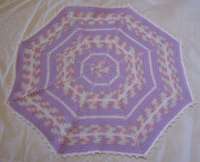I just discovered this site:
http://www.woolcrafting.com/index.html
In addition to having a number of free crochet patterns of which this is my favorite:

There is also a great deal of information for crocheters on this site. Want information about felting (fulling)? It’s here. Want free patterns? They’re are several here.
There are other felting projects and lots of information about yarns and fibers. Information on finishing, needlefelting, crochet stitches, crochet hooks, and charity crochet are all to be found here.
This site is a good resource for crocheters. Why not visit it soon and bookmark it for future reference?

Buttons
Collecting buttons has been one of the most popular hobbies of all times. Buttons can be used for a variety of purposes, right from holding a coat secure, to card-making and appliqué-work. But most importantly buttons add a touch of beauty and colour to life. Buttons are one of those little joys that create life delightful.
Some museums and art galleries hold culturally, historically, politically, and/or artistically significant buttons in their collections.
The Victoria & Albert Museum has many buttons, particularly
in its jewellery collection, as does the Smithsonian Institution.
Hammond Turner & Sons, a button-making company in Birmingham, hosts an online museum with an image gallery and historical button-related articles, including an 1852 article on button-making by Charles Dickens. In the USA, large button collect are on public display at The Waterbury Button Museum of Waterbury, Connecticut, and the Keep Homestead Museum of Monson, Massachusetts, which also hosts an extensive online button archive.
Early button history
Buttons and button-like objects used as ornaments or seals rather than fasteners have been discovered in the Indus Valley Civilization during its Kot Diji phase (circa 2800-2600 BCE) as well as Bronze Age sites in China (circa 2000-1500 BCE), and Ancient Rome.
Buttons made from seashell were used in the Indus Valley Civilization for ornamental purposes by 2000 BCE. Some buttons were carved into geometric shapes and had holes pierced into them so that they could be attached to clothing with thread. Ian McNeil (1990) holds that: “The button, in fact, was originally used more as an ornament than as a fastening, the earliest known being found at Mohenjo-daro in the Indus Valley. It is made of a curved shell and about 5000 years old.”
Functional buttons with buttonholes for fastening or closing clothes appeared first in Germany in the 13th century. They soon became widespread with the rise of snug-fitting garments in 13th- and 14th-century Europe.
Clothing Buttons.